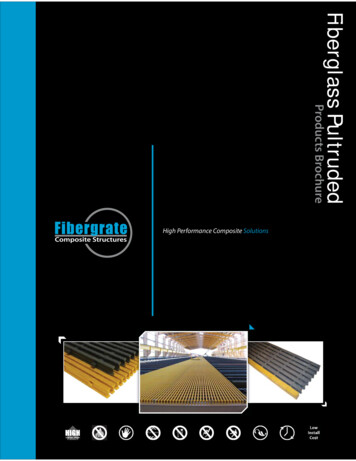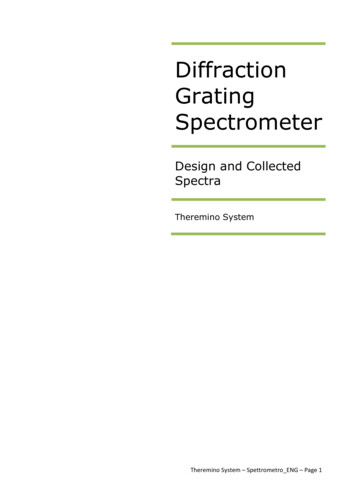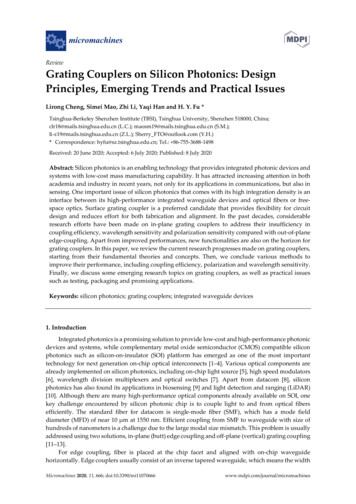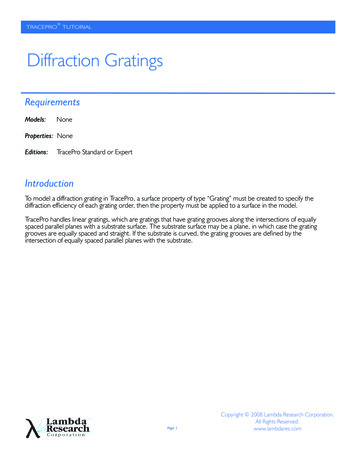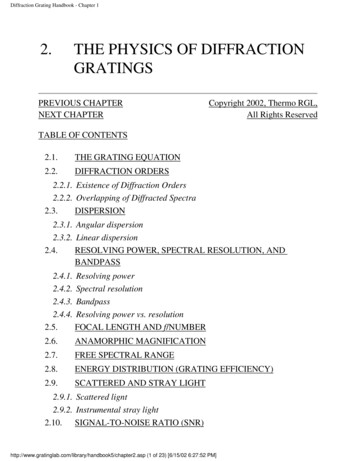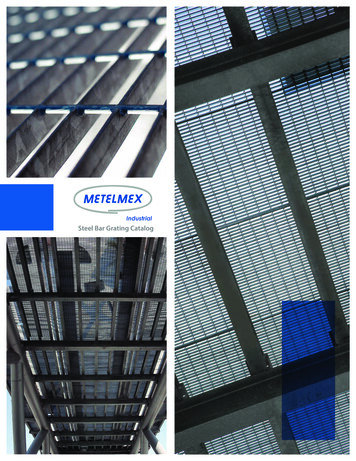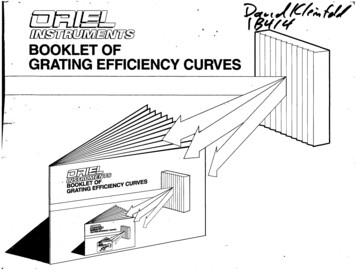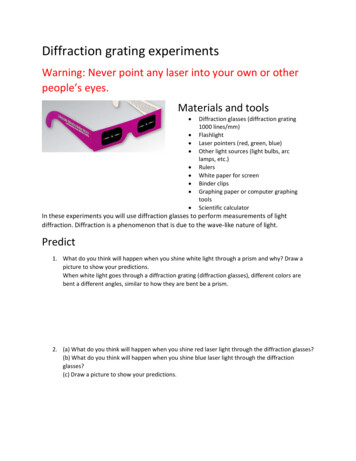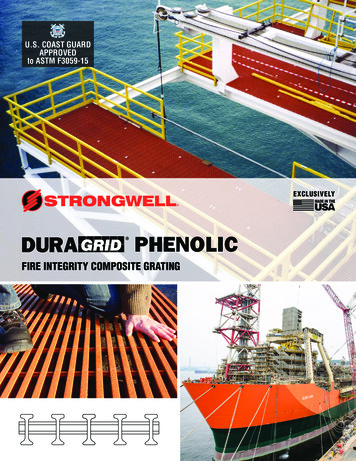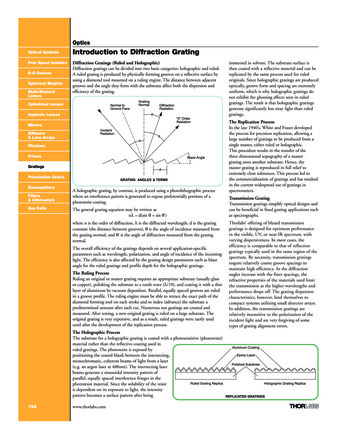
Transcription
14 Gratings 797-808.qxd.P7/11/078:28 AMPage 798OpticsOptical SystemsIntroduction to Diffraction GratingFree Space IsolatorsDiffraction Gratings (Ruled and Holographic)Diffraction gratings can be divided into two basic categories: holographic and ruled.A ruled grating is produced by physically forming grooves on a reflective surface byusing a diamond tool mounted on a ruling engine. The distance between adjacentgrooves and the angle they form with the substrate affect both the dispersion andefficiency of the grating.E-O DevicesSpherical SingletsMulti-ElementLensesCylindrical LensesAspheric LensesMirrorsDiffusers& Lens ArraysWindowsPrismsGratingsPolarization OpticsBeamsplittersFilters& AttenuatorsGas CellsA holographic grating, by contrast, is produced using a photolithographic processwhere an interference pattern is generated to expose preferentially portions of aphotoresist coating.The general grating equation may be written asnλ d(sin θ sin θ’)where n is the order of diffraction, λ is the diffracted wavelength, d is the gratingconstant (the distance between grooves), θ is the angle of incidence measured fromthe grating normal, and θ’ is the angle of diffraction measured from the gratingnormal.The overall efficiency of the gratings depends on several application-specificparameters such as wavelength, polarization, and angle of incidence of the incominglight. The efficiency is also affected by the grating design parameters such as blazeangle for the ruled gratings and profile depth for the holographic gratings.The Ruling ProcessRuling an original or master grating requires an appropriate substrate (usually glassor copper), polishing the substrate to a tenth wave (λ/10), and coating it with a thinlayer of aluminum by vacuum deposition. Parallel, equally spaced grooves are ruledin a groove profile. The ruling engine must be able to retrace the exact path of thediamond forming tool on each stroke and to index (advance) the substrate apredetermined amount after each cut. Numerous test gratings are created andmeasured. After testing, a new original grating is ruled on a large substrate. Theoriginal grating is very expensive, and as a result, ruled gratings were raerly useduntil after the development of the replication process.The Holographic ProcessThe substrate for a holographic grating is coated with a photosensitive (photoresist)material rather than the reflective coating used inruled gratings. The photoresist is exposed bypositioning the coated blank between the intersecting,monochromatic, coherent beams of light from a laser(e.g. an argon laser at 488nm). The intersecting laserbeams generate a sinusoidal intensity pattern ofparallel, equally spaced interference fringes in thephotoresist material. Since the solubility of the resistis dependent on its exposure to light, the intensitypattern becomes a surface pattern after being798www.thorlabs.comimmersed in solvent. The substrate surface isthen coated with a reflective material and can bereplicated by the same process used for ruledoriginals. Since holographic gratings are producedoptically, groove form and spacing are extremelyuniform, which is why holographic gratings donot exhibit the ghosting effects seen in ruledgratings. The result is that holographic gratingsgenerate significantly less stray light than ruledgratings.The Replication ProcessIn the late 1940’s, White and Frazer developedthe process for precision replication, allowing alarge number of gratings to be produced from asingle master, either ruled or holographic.This procedure results in the transfer of thethree dimensional topography of a mastergrating onto another substrate. Hence, themaster grating is reproduced in full relief toextremely close tolerances. This process led tothe commercialization of gratings and has resultedin the current widespread use of gratings inspectrometers.Transmission GratingTransmission gratings simplify optical designs andcan be beneficial in fixed grating applications suchas spectrographs.Thorlabs’ offering of blazed transmissiongratings is designed for optimum performancein the visible, UV, or near IR spectrum, withvarying dispersiveness. In most cases, theefficiency is comparable to that of reflectiongratings typically used in the same region of thespectrum. By necessity, transmission gratingsrequire relatively coarse groove spacings tomaintain high efficiency. As the diffractionangles increase with the finer spacings, therefractive properties of the materials used limitthe transmission at the higher wavelengths andperformance drops off. The grating dispersioncharacteristics, however, lend themselves tocompact systems utilizing small detector arrays.In addition, the transmission gratings arerelatively insensitive to the polarization of theincident light and are very forgiving of sometypes of grating alignment errors.
14 Gratings 797-808.qxd.P7/11/078:28 AMPage 799OpticsChoosing a Diffraction GratingOptical SystemsFree Space IsolatorsFactors in Selecting a Thorlabs GratingSelection of a grating requires consideration of a number offactors, some of which are listed below.Efficiency: In general, ruled gratings have a higher efficiencythan holographic gratings. Applications such as fluorescenceexcitation and other radiation-induced reactions may require aruled grating.Blaze Wavelength: Ruled gratings with a “sawtooth” grooveprofile have a relatively sharp efficiency peak around their blazewavelength, while some holographic gratings have a flatter spectralresponse. Applications centered around a narrow wavelength rangecould benefit from a ruled grating blazed at that wavelength.Wavelength Range: The spectral range covered by a grating isdependent on groove spacing and is the same for ruled andholographic gratings having the same grating constant. As a ruleof thumb, the first order efficiency of a grating decreases by 50%at 0.66λB and 1.5λB, where λB is the blaze wavelength. Note: Nograting can diffract a wavelength that is greater than 2 times thegroove period.Stray Light: For applications such as Raman spectroscopy, wheresignal-to-noise is critical, the inherent low stray light of aholographic grating is an advantage.Resolving Power: The resolving power of a grating is a measureof its ability to spatially separate two wavelengths. It is determinedby applying the Rayleigh criteria to the diffraction maxima; twowavelengths are resolvable when the maxima of one wavelengthcoincides with the minima of the second wavelength. Thechromatic resolving power (R) is defined by R λ/ λ nN,where λ is the resolvable wavelength difference, n is thediffraction order, and N is the number of grooves illuminated.E-O DevicesSpherical SingletsMulti-ElementLensesCylindrical LensesAspheric LensesMirrorsDiffusers& Lens ArraysWindowsPrismsGratingsDiffraction Grating Quick ReferenceRuledCustom Grating Sizes AvailableThese replicated, ruled diffraction gratings are offered in a variety of sizes and blaze angles. Ruled gratingstypically can achieve higher efficiencies than holographic gratings due to their blaze angles. Efficiency curvesfor all of these gratings are shown on the following pages to aid in selection of the appropriate grating.Polarization OpticsBeamsplittersFilters& AttenuatorsGas CellsSee Page 800HolographicThese gratings do not suffer from the periodic errors that can occur in ruled gratings, and hence, ghostedimages are nonexistent. Particularly in applications like Raman spectroscopy, where signal to noise is critical,the inherent low stray light of holographic gratings is an advantage. Thorlabs offers these gratings withspacings up to 3600 lines/mm.See Page 802EchelleThese gratings are special low period gratings designed for use in the high orders. They are generally usedwith a second grating or prism to separate overlapping diffracted orders. The resolution of an Echelle gratingbuilt on a precision glass substrate is typically 80-90% of the maximum theoretical resolution, which makesthem ideal for high resolution spectroscopy.See Page 804TransmissionTransmission gratings allow for simple linear (source - grating - detector) optical designs that canbebeneficial in making compact fixed grating applications such as spectrographs. In addition, the performanceof transmission gratings is insensitive to some types of grating alignment errors. Transmission and reflectiongratings have comparable efficiencies, which can be optimized for a specific spectral region by selecting theappropriate groove spacing and blaze angle. Transmission gratings are relatively insensitive to the polarizationof the incident light. Thorlabs offers gratings optimized for UV, near IR, and visible applications.See Page 805HANDLING OF GRATINGSThe surface of a diffraction grating can be easily damaged by fingerprints, aerosols, moisture, or the slightest contact with any abrasive material. Gratingsshould only be handled when necessary and always held by the sides. Latex gloves or a similar protective covering should be worn to prevent transfer of oilfrom fingers to the grating surface.Any attempt to clean a grating with a solvent voids the warranty. No attempt should be made to clean a grating other than blowing off dust with clean, dry airor nitrogen. Scratches or other minor cosmetic imperfections on the surface of a grating do not usually affect performance and are not considered defects.www.thorlabs.com799
14 Gratings 797-808.qxd.P7/11/078:29 AMPage 802OpticsOptical SystemsHolographic Diffraction GratingsFree Space IsolatorsHolographic gratings do not suffer from the periodic errors that can occurin ruled gratings, and thus, ghosted images are nonexistent. Particularly inapplications like Raman spectroscopy, where signal to noise is critical, theinherent low stray light of holographic gratings is an advantage. Thorlabsoffers these gratings with spacings from 600-3600 lines/mm.E-O DevicesSpherical SingletsMulti-ElementLensesCylindrical LensesAspheric LensesMirrorsDiffusers& Lens s Free From Random Spacing Errors (Virtually EliminatesGhosting)Versions Optimized for the UV or Visible SpectrumReflection Efficiency is Relatively Independent of Angle ofIncidence Compared to Ruled Gratings. Efficiencies: 45-65% at peak λ (in Littrow)Dimensional Tolerances: 0.5mmDamage Threshold: 350mJ/cm2 at 200ns (Pulsed);40W/cm2 (CW)Polarization OpticsBeamsplittersFilters& AttenuatorsGas nm0.50@500nm0.40@250nm0.33@500nm0.25@250nmUV OptimizedUV OptimizedUV OptimizedVIS OptimizedUV OptimizedVIS OptimizedUV OptimizedVIS OptimizedUV OptimizedUV OptimizedUV OptimizedUV OptimizedVIS OptimizedUV OptimizedVIS OptimizedUV OptimizedVIS OptimizedUV OptimizedUV OptimizedUV OptimizedUV OptimizedVIS OptimizedUV OptimizedVIS OptimizedUV OptimizedVIS OptimizedUV Optimized12.7 x 12.7 x 6mm12.7 x 12.7 x 6mm12.7 x 12.7 x 6mm12.7 x 12.7 x 6mm12.7 x 12.7 x 6mm12.7 x 12.7 x 6mm12.7 x 12.7 x 6mm12.7 x 12.7 x 6mm12.7 x 12.7 x 6mm25 x 25 x 6mm25 x 25 x 6mm25 x 25 x 6mm25 x 25 x 6mm25 x 25 x 6mm25 x 25 x 6mm25 x 25 x 6mm25 x 25 x 6mm25 x 25 x 6mm50 x 50 x 9.5mm50 x 50 x 9.5mm50 x 50 x 9.5mm50 x 50 x 9.5mm50 x 50 x 9.5mm50 x 50 x 9.5mm50 x 50 x 9.5mm50 x 50 x 9.5mm50 x 50 x 0-24UGH50-24VGH50-36U .00 20180.20180.20180.20180.20180.20180.20180.20 ,00RMB NDLING OF GRATINGSThe surface of a diffraction grating can be easily damaged by fingerprints, aerosols, moisture or the slightest contact with any abrasive material. Gratingsshould only be handled when necessary and always held by the sides. Latex gloves or a similar protective covering should be worn to prevent transfer of oilfrom fingers to the grating surface.Any attempt to clean a grating with a solvent voids the warranty. No attempt should be made to clean a grating other than blowing off dust with clean, dry airor nitrogen. Scratches or other minor cosmetic imperfections on the surface of a grating do not usually affect performance and are not considered defects.802www.thorlabs.com
14 Gratings 797-808.qxd.P7/11/078:29 AMPage 803OpticsHolographic Diffraction GratingsOptical SystemsFree Space Isolators100100909090808080706050403020Absolute Efficiency (%)100Absolute Efficiency (%)Absolute Efficiency (%)See our web site for large format 02001200300400Wavelength (nm)5006007008009001000Cylindrical Lenses3010400Multi-ElementLenses600300Spherical Singlets7010200E-O DevicesAspheric Lenses2001100300400Wavelength (nm)600 grooves/mm Optimized for the UV5006007008009001000MirrorsWavelength (nm)Diffusers& Lens Arrays1200 grooves/mm Optimized for the UV1000 grooves/mm Optimized for the UV10090909080808070605040302010Absolute Efficiency (%)100Absolute Efficiency (%)Absolute Efficiency 00Wavelength (nm)30600800100012003001800 grooves/mm Optimized for the UV8080707070605040302010Absolute Efficiency (%)9080Absolute Efficiency (%)100906050403020100500600500700800Wavelength (nm)2400 grooves/mm Optimized for the Filters& AttenuatorsGas Cells1800 grooves/mm Optimized for the Visible100400400Wavelength (nm)90300Beamsplitters201000200Polarization Optics40Wavelength (nm)1200 grooves/mm Optimized for the VisibleAbsolute Efficiency 100200250Wavelength (nm)2400 grooves/mm Optimized for the Visible300350400450500550600Wavelength (nm)3600 grooves/mm Optimized for the UVEfficiency Curve KeyPerpendicular Polarization.Parallel PolarizationAverage* All gratings are measured in the Littrowmounting configuration* All gratings utilize an aluminum (Al)reflective coatUSB 2.0 CCD Line Camera with External Trigger & 12-Bit Resolution3000 Pixel Linear CCD ArrayCapable of 190 scans/secondLC1-USBSee Page 963www.thorlabs.com803
14 Gratings 797-808.qxd.P7/11/078:30 AMPage 808OpticsOptical SystemsParameters of Diffraction GratingsFree Space IsolatorsEfficiencyGrating efficiency can be expressed as either absolute efficiency orrelative efficiency. The absolute efficiency of a grating is thepercentage of incident monochromatic radiation on a grating thatis diffracted into the desired order. This efficiency is determined byboth the groove profile (blaze) and the reflectivity of the grating’scoating. In contrast, relative (or groove) efficiency compares theenergy diffracted into the desired order with the energy reflected bya plane mirror coated with the same material as the grating. Allefficiency curves in this catalog are expressed as absolute.E-O DevicesSpherical SingletsMulti-ElementLensesCylindrical LensesAspheric LensesMirrorsDiffusers& Lens ArraysWindowsPrismsGratingsPolarization OpticsBeamsplittersFilters& AttenuatorsGas CellsBlaze Angle and WavelengthThe grooves of a ruled grating have a sawtooth profile with oneside longer than the other. The angle made by a groove’s longerside and the plane of the grating is the “blaze angle”. Changing theblaze angle concentrates the diffracted radiation of a specific regionof the spectrum, increasing the efficiency of the grating in thatspectral region. The wavelength at which maximum efficiencyoccurs is the blaze wavelength. Holographic gratings are generallyless efficient than ruled gratings because they cannot be blazed inthe classical sense. There are also special cases (e.g. when thespacing to wavelength ratio is near one) where a sinusoidal gratinghas virtually the same efficiency as a ruled grating. A holographicgrating with 1800 lines/mm can have the same efficiency at500nm as a blazed, ruled grating.Resolving Power:The resolving power of a grating is the product of the diffractedorder in which it is used and the number of grooves illuminatedby the incident radiation. It can also be expressed in terms ofgrating width, groove spacing, and diffracted angles. Resolvingpower is a property of the grating, and therefore, unlikeresolution, it is not dependent on the optical and mechanicalcharacteristics of the system in which it is used.System ResolutionThe resolution of an optical system, usually determined byexamination of closely spaced absorption or emission lines foradherence to the Rayleigh criteria (R λ/ λ), depends not only onthe grating resolving power but also on focal length, slit size, fnumber, the optical quality of all components, and systemalignment. The resolution of an optical system is usually much lessthan the resolving power of the grating.DispersionAngular dispersion of a grating is a function of the angles ofincidence and diffraction, the latter of which is dependent upongroove spacing. Angular dispersion can be increased by increasingthe angle of incidence or by decreasing the distance betweensuccessive grooves. A grating with a large angular dispersion canproduce good resolution in a compact optical system. Angulardispersion is the slope of the curve given by λ f(θ). In autocollimation, the equation for dispersion is given bydλλ . dθ2 tan θThis formula may be used to determine the angular separation oftwo spectral lines or the bandwidth that will be passed by a slitsubtending a given angle at the grating.808www.thorlabs.comDiffracted OrdersFor a given set of angles (θ, θ’) and groove spacing, the gratingequation is valid at more than one wavelength, giving rise to several“orders” of diffracted radiation.Constructive interference of diffracted radiation from adjacentgrooves occurs when a ray is in phase but retarded by a wholeinteger number of wavelengths. The number of orders produced islimited by the groove spacing and the angle of incidence, whichnaturally cannot exceed 90 . At higher orders, efficiency and freespectral range decrease while angular dispersion increases. Orderoverlap can be compensated for by the judicious use of sources,detectors, and filters and is not a major problem in gratings used inlow orders.Free Spectral RangeFree spectral range is the maximum spectral bandwidth that can beobtained in a specified order without spectral interference (overlap)from adjacent orders. As grating spacing decreases, the free spectralrange increases. It decreases with higher orders. If λ1 and λ2 arethe lower and upper limits, respectively, of the band of interest,thenFree Spectral Range λ2 - λ1 λ1/n.Grating NormalIncidentRadiationGhosts and Stray LightGhosts are defined as spurious spectral lines arising from periodicerrors in groove spacing. Interferometrically controlled ruling enginesminimize ghosts, while the holographic process eliminates them.On ruled gratings, stray light originates from random errors andirregularities of the reflecting surfaces. Holographic gratingsgenerate less stray light because the optical process, which transfersthe interference pattern to the photoresist, is not subject tomechanical irregularities or inconsistencies.SizesGratings are available in several standard square and rectangularsizes ranging from 12.5mm square up to 50mm square. Nonstandard sizes are available upon request. Unless otherwisespecified, rectangular gratings are cut with grooves parallel to theshort dimension.
images are nonexistent. Particularly in applications like Raman spectroscopy, where signal to noise is critical, the inherent low stray light of holographic gratings is an advantage. Thorlabs offers these gratings with spacings up to 3600 lines/mm. See Page 802 Echelle These gratings are special low period gratings designed for use in the high .
